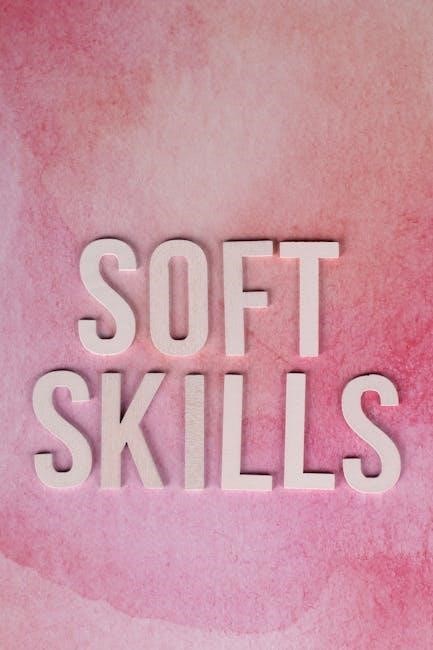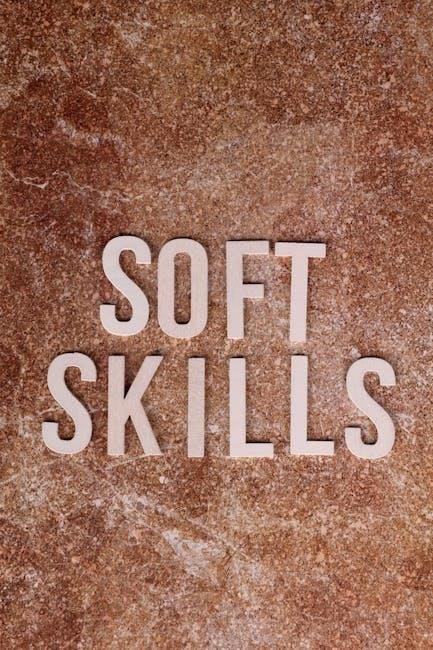
FYI: For Your Improvement by Michael Lombardo and Robert Eichinger is a guide for development and coaching, offering insights into 67 workplace competencies, career challenges, and global focus areas to aid personal and professional growth for learners, managers, and mentors.
1.1 Overview of the Guide
For Your Improvement: A Guide for Development and Coaching is a comprehensive resource designed to help individuals and organizations enhance personal and professional growth. It provides a structured approach to self-development, focusing on 67 core workplace competencies identified through the Leadership Architect framework. The guide offers practical tools, self-assessment techniques, and actionable advice to identify strengths and improvement areas. It emphasizes the importance of feedback, coaching, and creating personalized development plans. By addressing both individual and organizational needs, the guide serves as a roadmap for fostering continuous improvement and achieving long-term success in ever-evolving professional landscapes.
1.2 Importance of Development and Coaching in Personal and Professional Growth
Development and coaching are essential for fostering personal and professional growth, enabling individuals to enhance their skills, address weaknesses, and achieve their full potential. These practices promote self-awareness, resilience, and adaptability, which are critical in navigating today’s dynamic work environments. Coaching provides personalized guidance, helping individuals set clear goals and develop actionable plans. By investing in development, organizations cultivate a workforce capable of driving innovation and success. Continuous growth not only boosts career advancement but also enriches personal satisfaction, creating a win-win scenario for individuals and organizations alike.

Key Concepts and Frameworks
The guide outlines core frameworks like the 67 Workplace Competencies, Career Stallers, and Global Focus Areas, providing structured approaches to skill development and leadership growth effectively.
2.1 The 67 Workplace Competencies in Leadership Architect
The 67 Workplace Competencies in Leadership Architect are foundational skills identified as critical for professional success. These competencies span technical, interpersonal, and leadership abilities, providing a comprehensive framework for development. They include essential skills like communication, decision-making, and problem-solving, which are vital for personal and professional growth. The guide uses these competencies to help individuals identify strengths and improvement areas, offering practical tools for development planning. By focusing on these competencies, learners and coaches can create tailored strategies to enhance performance and achieve career goals effectively. This structured approach ensures a clear path for skill enhancement and professional advancement.
2.2 Understanding Career Stallers and Stoppers
Career Stallers and Stoppers are behaviors or patterns that hinder professional growth, often leading to stagnation or derailment. Stallers are habits that slow progress, such as avoiding challenges or lacking initiative, while Stoppers are more severe, like poor interpersonal skills or unethical behavior, which can derail careers entirely. Identifying these issues early is crucial for development. The guide provides practical strategies to address them, helping individuals overcome obstacles and stay on track for long-term success. By understanding these pitfalls, learners and coaches can create targeted plans to mitigate risks and foster sustainable growth. This ensures a clear path to achieving career goals.
2.3 Global Focus Areas for Managing Across Borders
Managing across borders requires understanding global focus areas that influence leadership and collaboration. These include cultural awareness, communication styles, and adaptability to diverse business environments. Leaders must navigate differences in workplace norms, decision-making processes, and hierarchical structures. Building trust and fostering relationships across borders are critical. The guide emphasizes strategies for managing global teams effectively, such as leveraging technology and embracing diversity. It also highlights the importance of understanding local regulations and market dynamics. By mastering these global focus areas, leaders can drive cross-border collaboration and achieve organizational success in an interconnected world.

Development Tools and Resources
This section provides practical tools and resources to support personal and professional growth, including self-assessment quizzes, action plans, and recommended materials for targeted development.
3.1 Self-Assessment Tools for Personal Development
Self-assessment tools are essential for identifying strengths, weaknesses, and areas for improvement. These tools, such as personality tests, skill assessments, and reflection exercises, help individuals gain insights into their competencies. They provide a clear framework for understanding personal and professional growth opportunities. By using these tools, learners can set realistic goals and create targeted development plans. Regular self-assessment fosters a growth mindset and accountability, enabling individuals to take ownership of their development journey. These tools are often paired with feedback from others to ensure a well-rounded understanding of one’s abilities and areas for enhancement.
3.2 Action Plans for Improvement
Action plans are structured strategies to address development gaps and achieve growth goals. They involve setting specific, measurable objectives and identifying the resources and support needed. Key steps include defining timelines, assigning accountability, and establishing milestones for progress tracking. Effective plans also incorporate feedback mechanisms to ensure adjustments can be made as needed. By creating a clear roadmap, individuals can systematically work on improving their skills and overcoming challenges. Regular reviews and updates to the plan help maintain focus and motivation, ensuring sustained progress toward personal and professional development.
3.3 Bibliographical References and Further Reading
The guide provides a comprehensive list of bibliographical references to support deeper exploration of development topics. These resources include books, articles, and research papers on leadership, coaching, and personal growth. Authors like Michael Bungay Stanier, Brené Brown, and Daniel Goleman are often cited for their insights into effective development strategies. Readers are encouraged to explore these materials to gain additional perspectives and practical tools. The references are curated to align with the guide’s focus on actionable development, ensuring learners have access to trusted sources for continued growth. This section serves as a gateway to further learning and professional enrichment.

Coaching Strategies for Managers and Mentors
This section provides practical strategies for managers and mentors to enhance their coaching skills, fostering growth and collaboration within teams.
4.1 Effective Feedback Techniques
Effective feedback is a cornerstone of successful coaching, enabling individuals to identify strengths and areas for improvement; To deliver impactful feedback, focus on specificity, ensuring comments are clear and actionable. Use the Situation-Behavior-Impact (SBI) framework to structure conversations, linking observed behaviors to their outcomes. Timeliness is crucial—address issues promptly while they are relevant. Balance positive reinforcement with constructive criticism to maintain morale and motivation. Encourage a two-way dialogue, allowing the coachee to share perspectives and ask questions. This approach fosters trust and creates a safe environment for growth and development. Consistency in feedback ensures continuous learning and progress.
4.2 Building Trust in the Coach-Coachee Relationship
Trust is the foundation of a successful coach-coachee relationship, fostering open communication and mutual respect. Coaches should demonstrate empathy, understanding, and a genuine interest in the coachee’s growth. Consistency and reliability are essential, as is maintaining confidentiality to create a safe space for sharing. Active listening and acknowledging the coachee’s perspectives build credibility. Coaches should avoid judgment and instead focus on empowering the coachee to take ownership of their development. By aligning actions with words and maintaining professional boundaries, trust deepens, enabling a collaborative and productive partnership. This trust is vital for meaningful progress and lasting success;
4.3 Creating a Supportive Environment for Growth
A supportive environment is crucial for fostering growth and development; Coaches should encourage open dialogue, promoting psychological safety where coachees feel comfortable sharing challenges and ideas. Celebrating progress, no matter how small, reinforces motivation and builds confidence. Coaches should adapt their approach to meet individual needs, ensuring a personalized experience. Encouraging self-reflection and self-directed learning empowers coachees to take charge of their development. By cultivating a positive and nonjudgmental space, coaches enable coachees to explore possibilities, embrace challenges, and grow both personally and professionally. This nurturing environment lays the groundwork for sustained improvement and long-term success.

Practical Applications of the Guide
This guide bridges the gap between self-assessment and action, offering practical strategies for skill development, avoiding career derailment, and addressing personal and professional challenges effectively.
5.1 Using the Guide for Skill Development
The guide provides a structured approach to skill development, helping individuals identify gaps and create actionable plans. By leveraging the 67 workplace competencies, users can focus on specific areas for growth. Practical tools, such as self-assessment exercises and real-world examples, enable learners to apply concepts effectively. The guide emphasizes continuous learning, offering strategies to enhance proficiency over time. It also highlights the importance of feedback and tailored development plans, ensuring a personalized approach to skill improvement. This section equips users with the techniques and resources needed to build and refine their professional capabilities systematically.
5.2 Avoiding Career Derailment
The guide emphasizes early identification of career derailment risks, such as poor relationships, lack of adaptability, or inadequate leadership skills. It provides strategies to address these issues proactively, ensuring sustained career growth. By focusing on self-awareness and feedback, individuals can pinpoint vulnerabilities and develop targeted improvement plans. The guide also offers practical advice on navigating organizational politics and building a strong professional network. These insights help learners avoid common pitfalls, ensuring their career trajectory remains on track. This section is crucial for anyone aiming to maintain momentum and achieve long-term success in their professional journey.
5.3 Addressing Personal and Professional Challenges
The guide provides practical strategies for overcoming personal and professional challenges, fostering resilience and adaptability. It highlights the importance of self-awareness in identifying root causes of setbacks and offers tools to address them effectively. By creating actionable plans and leveraging feedback, individuals can transform challenges into growth opportunities. The guide also emphasizes balancing personal well-being with professional demands, ensuring sustainable development. This section equips learners with the skills to navigate obstacles confidently, aligning their actions with long-term goals and aspirations for holistic success.

The Role of Learners and Feedback Givers
The role of learners and feedback givers is central to effective development. Both parties share responsibility for fostering growth through open communication and mutual accountability.
6.1 Taking Ownership of Development
Taking ownership of development is crucial for personal and professional growth. Learners must acknowledge their accountability for improving skills and addressing weaknesses. Self-assessment tools help identify areas for growth, while setting clear goals ensures focus. Proactively seeking feedback and implementing changes demonstrates commitment. Learners should create a development plan, track progress, and reflect on outcomes; Ownership fosters self-awareness, initiative, and resilience, empowering individuals to drive their journey. Continuous improvement becomes a mindset, leading to sustained success; By taking charge, learners maximize the effectiveness of coaching and resources, ensuring long-term development. This proactive approach is essential for achieving both personal and organizational goals.
6.2 Providing Constructive Feedback
Providing constructive feedback is essential for fostering growth and improvement. It involves delivering clear, specific, and timely insights that focus on behavior rather than personality. Feedback should be actionable, allowing individuals to understand what they did well and how they can improve. Using “what” and “how” questions encourages reflection and helps recipients identify steps for development. Balancing positive reinforcement with corrective suggestions ensures feedback is well-received. Practicing active listening and maintaining a supportive tone builds trust. Following up after feedback demonstrates commitment to development. Effective feedback fosters a culture of continuous improvement and mutual growth.
6.3 Engaging in Continuous Learning
Continuous learning is a cornerstone of personal and professional growth. It involves actively seeking opportunities to expand knowledge, skills, and perspectives. By embracing lifelong learning, individuals stay adaptable in a rapidly changing world. This can be achieved through formal training, self-study, or experiential learning. Encouraging curiosity and a growth mindset fosters resilience and innovation. Regularly reflecting on experiences and seeking feedback enhances learning effectiveness. Prioritizing continuous learning ensures individuals remain competitive and capable of addressing new challenges. Organizations that promote a culture of learning empower employees to thrive and contribute meaningfully to long-term success.

Leadership Development and Organizational Impact
Leadership development enhances individual and organizational performance, fostering a culture of growth and innovation. It aligns personal goals with business objectives, driving measurable impact and sustainability.
7.1 Translating Individual Development into Business Results
Individual development directly impacts organizational success by aligning personal growth with business objectives. When employees enhance their skills and competencies, they contribute more effectively to strategic goals. This translation occurs through improved decision-making, increased productivity, and enhanced collaboration. Leaders who prioritize development foster a culture of continuous improvement, driving innovation and efficiency. By measuring the impact of development programs, organizations can ensure investments yield tangible results, such as revenue growth or market expansion. Ultimately, individual progress becomes a catalyst for broader business outcomes, creating a symbiotic relationship between personal and professional success. This alignment is key to sustained organizational effectiveness.
7.2 Building a Culture of Development in Organizations
Creating a culture of development within organizations requires intentional effort and commitment from leadership. Leaders must prioritize development by allocating resources, encouraging learning, and modeling growth behaviors themselves. Managers play a pivotal role by fostering open conversations about development and providing opportunities for skill enhancement. Regular feedback loops, mentoring programs, and cross-functional collaboration further reinforce this culture. Recognizing and rewarding developmental efforts motivates employees to engage deeply. When development becomes ingrained in daily operations, organizations cultivate a workforce that is adaptable, innovative, and better equipped to meet evolving business demands. This culture drives long-term success and sustainability.
7.3 Measuring the Effectiveness of Development Programs
Evaluating development programs is crucial to ensure they deliver intended outcomes. Metrics such as participation rates, skill improvements, and feedback from participants provide insights into program effectiveness. Assessing business impact, like enhanced performance or productivity, further validates the programs’ value. Regular surveys, focus groups, and performance reviews help gather qualitative and quantitative data. Using tools like Kirkpatrick’s Model can structure the evaluation process; Aligning metrics with organizational goals ensures relevance and accountability. Continuous monitoring and adjustments based on feedback foster ongoing improvement and maximize the return on investment in development initiatives. This data-driven approach ensures programs remain impactful and aligned with strategic objectives.

Advanced Techniques for Coaches and Mentors
This section explores refined coaching methods, including deep dives into competency development, cross-cultural team management, and advanced feedback strategies to elevate mentorship effectiveness.
8.1 Deep Dive into Competency Development
This section focuses on advanced methods for enhancing specific workplace competencies, ensuring they align with organizational goals and individual career aspirations. Coaches and mentors learn how to assess current skill levels, identify gaps, and create tailored development plans. Practical strategies include targeted learning exercises, real-world application opportunities, and continuous feedback loops to monitor progress. The emphasis is on fostering sustainable growth by linking competency development to measurable performance improvements and long-term business outcomes. This approach ensures that individuals not only acquire new skills but also apply them effectively in their roles, driving both personal and professional success.
8.2 Managing Cross-Cultural and Global Teams
This section provides insights into effectively leading teams across cultural and geographic boundaries. Coaches and mentors learn strategies to navigate cultural differences, communicate clearly, and build trust in diverse environments. Key topics include understanding cultural nuances, fostering collaboration across time zones, and managing language barriers. Emphasis is placed on creating inclusive environments where diverse perspectives thrive. Practical tools and techniques are shared to enhance cross-cultural leadership skills, ensuring teams remain aligned with organizational goals while respecting individual differences. This enables leaders to drive productivity and innovation in global settings effectively.
8.3 Advanced Feedback Strategies
This section delves into sophisticated techniques for delivering and receiving feedback, essential for fostering growth in complex environments. It explores methods like situational feedback, where input is tailored to specific contexts, and the use of data analytics to inform feedback. Advanced strategies include fostering psychological safety to encourage openness and addressing systemic barriers that hinder effective communication. Coaches learn to navigate power dynamics and cultural sensitivities, ensuring feedback is both constructive and respectful. These approaches empower individuals and teams to embrace feedback as a catalyst for continuous improvement and innovation.

Case Studies and Success Stories
This section highlights real-world applications of the guide, showcasing success stories where individuals and teams achieved significant growth through its principles and practices.
9.1 Real-World Applications of the Guide
This section shares practical examples of how individuals and organizations have applied the guide’s principles to drive personal and professional growth. Readers will discover how the guide’s frameworks, such as the 67 Leadership Architect competencies, have been used to improve leadership skills, address career challenges, and enhance team performance. Real-world case studies illustrate how professionals across industries have leveraged the guide’s tools, like action plans and feedback techniques, to achieve measurable results. These stories highlight the guide’s versatility and effectiveness in various contexts, from corporate environments to individual development journeys.
9;2 Success Stories from Learners and Coaches
This section showcases inspiring success stories from individuals who have applied the guide’s principles to achieve significant personal and professional growth. Learners share how they overcame challenges, enhanced their skills, and advanced their careers using the guide’s tools. Coaches also highlight how the guide helped them improve their mentoring techniques, fostering stronger relationships and driving results. These stories demonstrate the guide’s practicality and effectiveness, offering motivation and proof of its impact in real-world scenarios. They illustrate how the guide empowers individuals and organizations to thrive through focused development and coaching.
9.3 Overcoming Common Development Challenges
This section addresses common obstacles learners and coaches face during development journeys. It provides practical strategies to tackle challenges like resistance to feedback, lack of motivation, and unclear goals. The guide emphasizes the importance of self-assessment, action planning, and continuous learning. By offering tools to break down complex issues into manageable steps, it helps individuals and organizations overcome barriers such as limited resources or cultural resistance. The focus is on fostering resilience and creating a supportive environment where growth thrives, ensuring sustainable progress despite challenges.
This section summarizes the guide’s key insights, emphasizing sustained growth through continuous learning and feedback. It encourages creating a personalized development plan to apply the strategies effectively.
10.1 Summarizing Key Takeaways
This section recaps the guide’s core principles, emphasizing self-awareness, actionable feedback, and tailored development plans. It highlights the importance of ownership, trust, and continuous learning in growth. Practical tools like competency frameworks and cross-cultural strategies are underscored, alongside real-world applications and success stories. The guide ultimately serves as a roadmap for transforming insights into measurable results, empowering individuals and organizations to achieve sustainable development. By focusing on these key takeaways, learners can effectively navigate their improvement journey and foster lasting change.
10.2 Creating a Personal Development Plan
A personal development plan outlines actionable steps for growth, aligning goals with strengths, weaknesses, and aspirations. Start by setting SMART (Specific, Measurable, Achievable, Relevant, Time-bound) goals, focusing on key competencies. Identify resources, such as mentors or courses, to support progress. Regularly review and adjust the plan to stay on track. Incorporate feedback from coaches or peers to refine strategies. Prioritize self-accountability and celebrate milestones to maintain motivation. This structured approach ensures intentional growth, helping individuals achieve both personal and professional objectives effectively.
10.3 Continuous Improvement and Growth
Continuous improvement is a lifelong commitment to learning and self-enhancement. It involves embracing a growth mindset, where challenges are seen as opportunities for development. Regularly reflect on experiences, successes, and setbacks to identify areas for refinement. Seek feedback and apply it to refine skills and behaviors. Stay curious and open to new ideas, adapting to evolving circumstances. By integrating learning into daily routines, individuals can sustain momentum and achieve long-term growth. This ongoing process fosters resilience, adaptability, and sustained success in both personal and professional realms, ensuring steady progress over time.

Additional Resources and References
This section provides curated resources, including recommended books, online courses, and tools, to support ongoing development and coaching efforts, enhancing your growth journey.
11.1 Recommended Reading for Further Development
To deepen your understanding and enhance your growth, explore these recommended books: “The Leadership Challenge” by James Kouzes and Barry Posner, “Emotional Intelligence 2.0” by Travis Bradberry, and “Drive” by Daniel Pink. These books offer insights into leadership, self-awareness, and motivation, aligning with the principles of “For Your Improvement.” Additionally, “The Art of Coaching” by Elena Aguilar provides practical coaching strategies, while “Mindset: The New Psychology of Success” by Carol Dweck explores growth mindset principles. These resources complement the guide, offering actionable advice and real-world applications for personal and professional development.
11.2 Online Tools and Platforms for Development
Enhance your development journey with these online tools and platforms: LinkedIn Learning offers courses on leadership and soft skills, while Coursera and Udemy provide diverse professional development programs. Gallup’s CliftonStrengths helps identify strengths, and MindTools offers practical resources for skill improvement. Platforms like 15Five and Lattice facilitate continuous feedback and alignment with goals. These tools align with “For Your Improvement” by providing structured pathways for learning, self-assessment, and growth, ensuring a holistic approach to personal and professional development. They empower individuals to take charge of their progress effectively.
11.3 Joining Development Communities and Networks
Engaging with development communities and networks accelerates growth and provides valuable connections. Platforms like LinkedIn Groups and industry-specific forums offer spaces for sharing insights and best practices. Professional associations such as SHRM or Dale Carnegie host events and webinars. Local meetups and virtual groups on Meetup or Slack communities also foster collaboration. These networks provide opportunities for mentorship, feedback, and accountability, aligning with the guide’s emphasis on continuous learning and development. By joining these communities, individuals can gain new perspectives, build relationships, and stay motivated on their growth journey.
